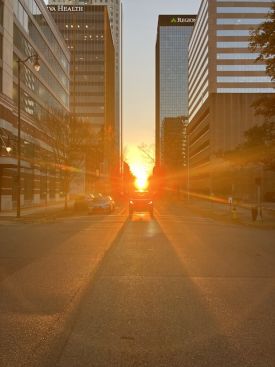Birminghenge
"Birminghenge" or "Birminghamhenge" is a term referring to the coincidence between the position of the setting sun and the Birmingham city center street grid when the setting sun is framed within the width of Birmingham's east-west avenues.
Birmingham's avenues, laid out in 1871 by William Barker, parallel the route of the Northeast & Southwest Railroad, which itself generally follows the orientation of Jones Valley, as defined to the south by Red Mountain. The resulting grid is rotated approximately 29-30° west of true north, i.e. 240-241°.
By chance, this nearly perfectly aligns with the azimuth of the sun just before it begins to set as seen from Birmingham during the period surrounding the winter solstice (241.93° at 4:41:43 PM CST on December 21).
The term "Birminghenge" plays on Wiltshire, England's famed neolithic stone circle, called "Stonehenge" which was constructed to mark the position of the sunrise at the summer solstice (behind the heel stone), and the sunset at winter solstice (framed through what was once the monument's tallest trilithon, no longer standing).
A similar phenomenon has been celebrated in other cities with regular downtown street grids. Astrophysicist Neil deGrasse Tyson is credited with popularizing the term "Manhattanhenge" beginning in 2001, to describe the phenomenon which can be observed at sunset on May 28 and July 13 in central Manhattan, New York, where the street grid is 29° east of true north.
Likewise, in 2009 the Chicago Reader reported on a similar occurrence in Chicago, Illinois, where the street grid is aligned with the cardinal directions. Therefore the event is observable there on the equinoxes (March 21 and September 22).
Birmingham's situation is unusual in that, like at Stonehenge, the solar alignment occurs on the winter solstice, which has long been a significant annual event in many cultures. Because the southward change in position of the sunset slows as the date of the solstice approaches, and then slowly reverses direction in the days following the solstice, the Birminghenge phenomenon is visible on clear days over a period of approximately two weeks, from December 14 through 28.
References
- Moser, Whet (August 20, 2009) "Chicagohenge!" Chicago Reader
- Iezzi, Teressa (May 29, 2015) "How Neil deGrasse Tyson Discovered Manhattanhenge." Fast Company
- Anderson, Bianca (March 12, 2020) "Understanding Chicagohenge." AstroFan blog. Adler Planetarium
External links
- NOAA Solar Calculator at noaa.gov
